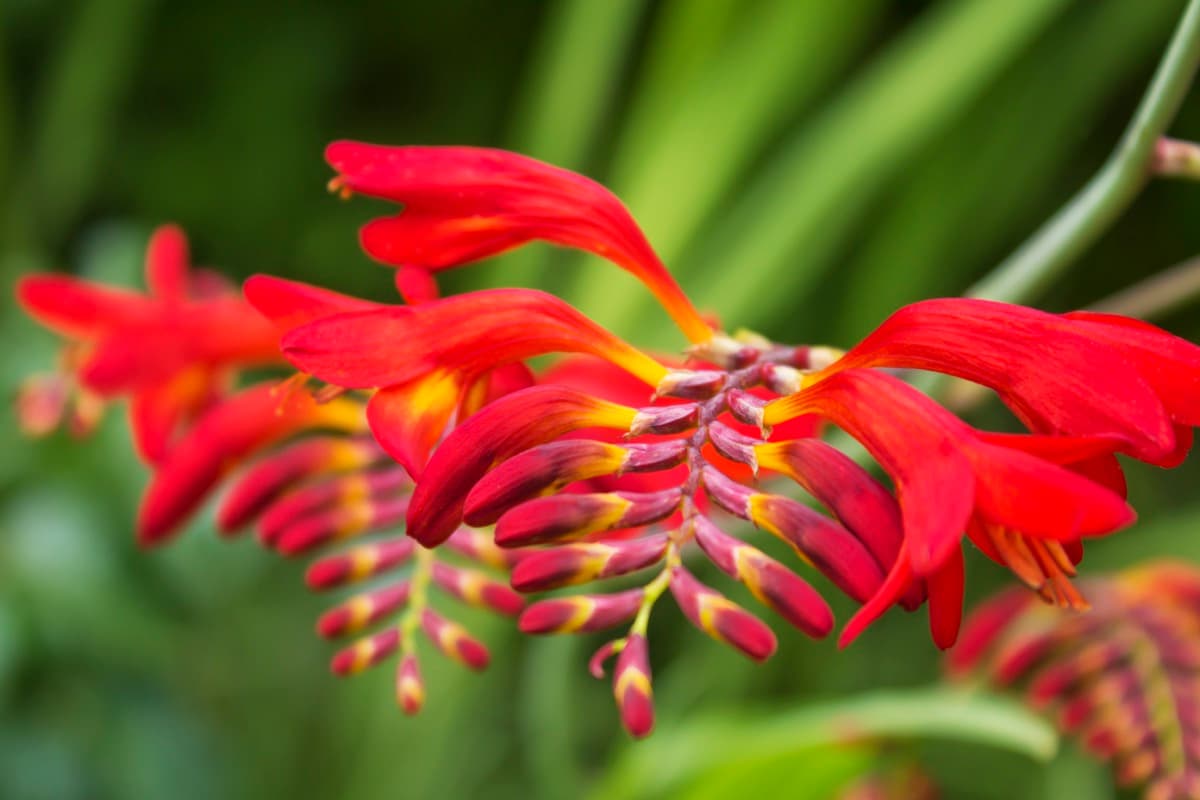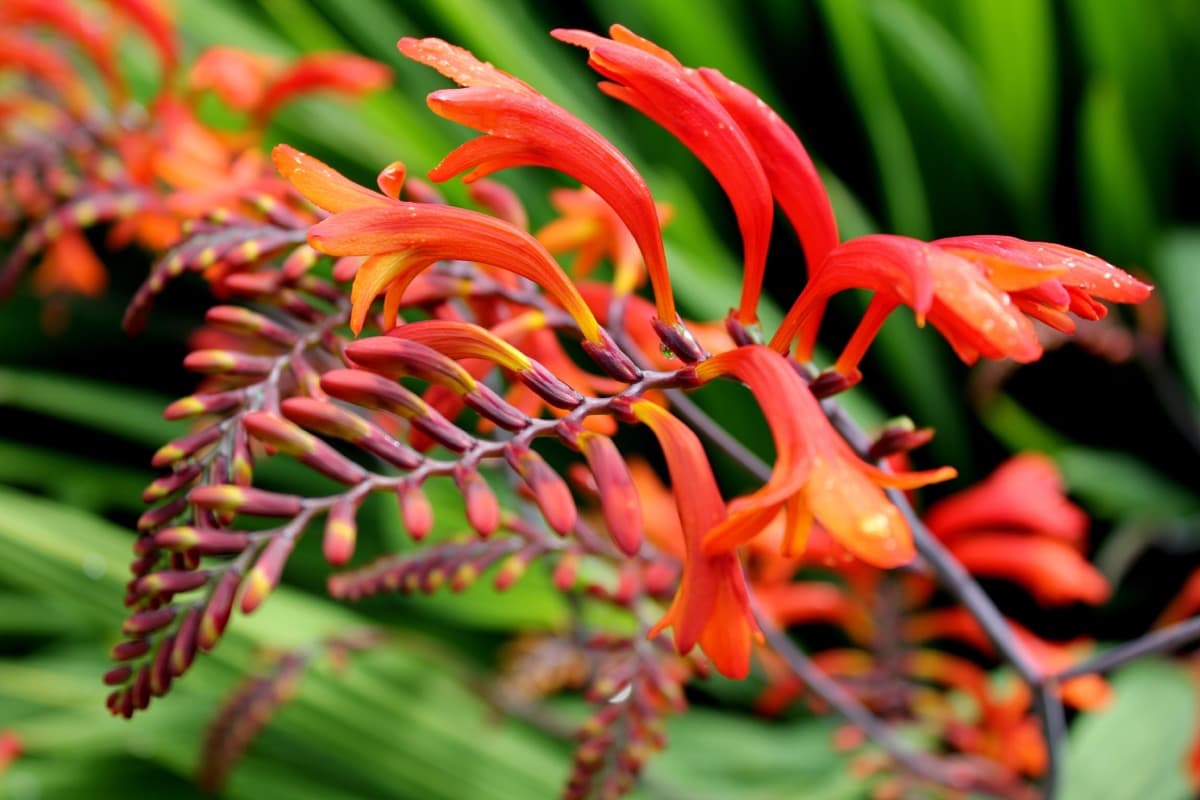Crocosmia, also known as montbretia, is a small genus of flowering plants belonging to the iris family, Iridaceae. These stunning plants are easy to grow and require minimal maintenance, making them a good addition to any garden.

How to Grow and Care for Crocosmia Plants
Choosing The Right Location for Crocosmia Plant Growth
- Crocosmia plants thrive in full to partial sun locations and require at least six hours of direct sunlight daily. Therefore, when choosing the right location for Crocosmia plant growth, it’s essential to consider the amount of light available in the area.
- Choosing a spot that provides shelter from strong winds is also crucial, as they can severely damage these delicate plants. When planted near walls or fences, they’re less likely to be affected by strong gusts.
- Consider the overall look you want for your garden or landscape design when selecting a location for Crocosmia plant growth. They make excellent border plants due to their tall stems and vibrant blooms that attract pollinators like bees and butterflies.
Optimal Soil Conditions for Healthy Crocosmia Plant Growth
- Crocosmia plants thrive in specific soil conditions that provide sufficient nutrients and moisture for healthy growth. To ensure your Crocosmia plant flourishes, it is crucial to understand the optimal soil conditions required.
- Select a fertile soil that contains high levels of organic matter. Maintain a neutral pH level between 6.0 to 8.0 for effective nutrient uptake by roots and overall plant health.
- Avoid planting Crocosmia in areas with poorly-draining soils, as this can lead to root rot caused by excess moisture, which can weaken or kill your plant over time.
Understanding Crocosmia Plant’s Water and Moisture Requirements
- Crocosmia plants require consistent watering to thrive. Keep the soil moist but not waterlogged. Watering once or twice a week is usually sufficient, but adjusting based on your specific climate and weather conditions is important.
- In addition to regular watering, Crocosmia plants also benefit from increased humidity levels. This can be achieved by leaves misting with water or by placing a tray of pebbles filled with water underneath the plant pot. However, it’s important not to overwater Crocosmia as this can lead to some plant issues. To prevent this, ensure that your pot has good drainage holes and avoid leaving standing water in saucers for extended periods.
- Understanding the Crocosmia plant’s water and moisture requirements is crucial for ensuring healthy growth and vibrant blooms.
In case you missed it: How to Start Marigolds in Pots: Best Practices for Growing From Seeds and Transplants

Identifying and Treating Pests and Diseases in Crocosmia Plants
- Crocosmia plants are susceptible to various pests and diseases but can be easily managed with proper care and vigilance. One common pest that attacks Crocosmia is the aphid. These small insects suck sap from the leaves and stem, causing stunted growth and yellowing foliage. A simple solution is to spray the plant with soapy water or use insecticidal soap to get rid of them.
- Another pest that may crop up on your Crocosmia plant is spider mites. These tiny arachnids also feed on sap causing visible damage to the leaves. You can try using a miticide or washing them off with a strong stream of water to control them.
- Diseases like rust or fungal infections can also affect your Crocosmia plant’s health. Rust appears as orange spots on the underside of leaves, while fungal infections cause leaf spotting or rotting at the soil level. For rust, remove affected leaves promptly; for fungus, apply fungicide following instructions carefully.
Seasonal Care Guide for Crocosmia Plants: Spring, Summer, Fall, and Winter
- Spring is the perfect time to plant Crocosmia bulbs. As the weather warms up and the soil begins to thaw, it’s important to prepare your garden beds by adding compost or other organic matter. Once planted, keep the soil lightly moist but not too wet until sprouts begin to emerge.
- Crocosmia plants shine in summer with vibrant orange, yellow and red blooms. During this season, it’s important to ensure they receive adequate water and some shade during hot afternoons.
- Crocosmia plants will die in the fall as part of their natural growth cycle. It’s important not to cut them down immediately as they still need time for photosynthesis before going dormant for winter. You can also divide crowded clumps into smaller groups this time of year.
- Crocosmia bulbs should be protected from extremely cold temperatures by covering them with mulch or leaves in winter. This will help insulate them against freezing weather while providing valuable nutrients for spring growth.
Feeding and Fertilizing Crocosmia Plants for Vibrant Blooms
- It is essential to encourage healthy growth and vibrant blooms. The best time to feed your plants is in early spring, which will help provide the necessary nutrients for a strong start.
- Select a balanced fertilizer with equal nitrogen, phosphorus, and potassium. You can use organic fertilizers if you prefer an all-natural approach.
- Apply the fertilizer evenly around the plant base, taking care not to get any on the leaves or flowers. Water thoroughly after applying the fertilizer to help it soak into the soil.
- During the growing season, you can continue feeding your Crocosmia plants every six weeks using a liquid fertilizer mixed with water according to package instructions.
- By providing adequate nutrition through proper feeding and fertilization techniques, you’ll be rewarded with healthy Crocosmia plants that produce stunning blooms year after year.
Protecting Crocosmia Plants from Extreme Temperatures and Frost
- Crocosmia plants are quite hardy and can withstand various temperatures, but they require some protection from extreme weather conditions. During winter, protecting your Crocosmia plants from frost damage is important.
- One way to protect your Crocosmia plants is by covering them with a layer of mulch. This will help insulate the soil and roots against freezing temperatures. You can use any organic material for mulching, such as straw, leaves, or compost.
- Another method you can try is using frost cloths or blankets to cover the plants during cold snaps. These materials trap heat close to the plant and prevent frost formation on their surface.
- It’s also essential to avoid watering your crocosmias when there is an impending storm or freeze event in your area since water on foliage accelerates freezing rates which could damage the leaves and stem.
- If you live in an area with severe winters where snow accumulates heavily, clearing snow off Croscosmia would be recommended as too much weight might break its stem structure, causing irreparable harm.
Crocosmia Plant Maintenance: Pruning and Deadheading Techniques
- Pruning and deadheading Crocosmia plants are vital to maintain their health and keep them looking beautiful. Deadheading is the way of removing spent flowers, while pruning refers to cutting back stems and leaves.
- The best time to deadhead Crocosmia plants is when the blooms have faded. This prevents seed formation, which can take away important nutrients from the plant. Use sharp scissors or pruners to cut off the spent flower stalks above where they meet the foliage.
- Pruning should be done in early spring before new growth appears. Cut back any damaged or diseased leaves and stems and any that appear overcrowded or crossing over each other. Prune them down to about 6 inches above ground level.
In case you missed it: How to Grow and Care for Scarlet Bee Balm: Planting Instructions

Conclusion
Crocosmia is a beautiful flowering plant that can brighten up any garden or landscape. Growing and caring for Crocosmia plants can be a rewarding experience for any gardener. With the right growing conditions, regular maintenance, and proper care techniques, these vibrant blooms will flourish in your garden year after year.
- Feed Your Flock for Less: Top 10 Tips to Save on Chicken Feed
- Ultimate Guide to Ossabaw Island Hog: Breeding, Raising, Diet, and Care
- Hatching Answers: The Top 10 Reasons Your Chickens Aren’t Laying Eggs
- Eggs and Economics: Breaking Down the Cost of Raising Backyard Chickens
- Defend Your Greens: Proven Methods to Keep Iguanas Out of Your Garden
- Ultimate Guide to Cinnamon Queen Chicken: A Comprehensive Guide for Beginners
- Ultimate Guide to California Tan Chicken: Breeding, Raising, Diet, Egg-Production and Care
- Ultimate Guide to Marsh Daisy Chicken: Breeding, Raising, Diet, and Care
- 10 Types of Chicken Farming Businesses You Can Start for Profits